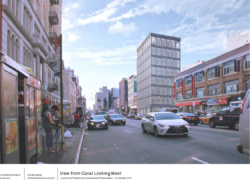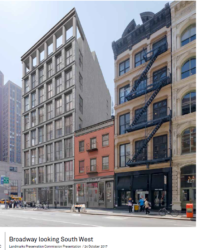
Rendering 419 Broadway. Image Credit LPC.
Application would see demolition of 3 structures, construction of new 8-story development, and restoration of an 1823 Italianate building. On October 24, 2017, the Landmarks Preservation Commission considered an application concerning three properties at the corner of Canal Street and Broadway in SoHo-Cast Iron Historic District. The applicant proposed to demolish existing buildings, at 419–421 Broadway and 301 Canal Street, and develop a new 135-foot-tall commercial structure. The new building would span the lots of the demolished structures.
The proposal would see the restoration of an adjoining structure, at 423 Broadway, as part of a 74-11 application, in which City Planning may grant waivers for use and bulk after receiving a report from Landmarks for the restoration and preservation plan of a historic structure.
Albert Laboz, a principal at United American Land, the owner, said the development would “build a great building at the gateway of SoHo,” while serving to “restore a great Federal building.”
Attorney for the applicants Valerie Campbell detailed the waivers sought under the 74-11 application. Use regulations would be modified to allow retail use on the first floor of both the new building and the landmark structure. Heights and setback regulations would also be waived for the new building, allowing the structure to be built to the planned height, and obviating the need for a setback at 85 feet. She stated that air rights would be transferred from 423 Broadway to the new building, serving a preservation purpose by allowing the floor area to be massed in an appropriate location
Consultant Erin Rulli of Higgins Quasebarth said the corner’s current condition was that of an “urban void” at the district’s southern boundary, and presented an opportunity for a “compelling new design” that would “anchor the corner.” Rulli testified that the existing building at 301 Canal Street, though originally constructed as a two-story building in the mid-19th century had undergone severe alterations, and retained no historic exterior fabric. 419 and 421 Broadway were originally built in 20th century at four stories, and were later reduced to one story and merged.
Originally built in 1823 as a two-story rowhouse, Rulli said the building at 423 Broadway would be restored to its 19th-century three-story commercial appearance. Brickwork would be repaired and repointed, non-historic paint stripped away, a cornice restored, sills and coping would be replaced with cast stone mimicking historic brownstone, and the roof reclad in slate. Non-historic fire escape elements would be removed. Historic lintels would be exposed and restored, as would masonry on the rear. The building currently has a contemporary storefront, and a new wooden storefront would be installed as part of the restoration. A new dormer would be created at the third story
The interior would be altered, with floor plates rebuilt to match those of the new building which would be connected at the south wall, but the alterations will not affect the exterior.
Rulli said that structures of similar height to the proposed building had been developed along Broadway, and the juxtaposition of a taller building next to low Federal buildings was common in the historic district.

Rendering 419 Broadway. Image Credit LPC.
Architect Morris Adjmi presented the plan for the proposed new building, which he said was inspired by SoHo’s cast-iron architecture. The building would have a strong base-shaft-top arrangement, as do the cast-iron building of SoHo. The Canal and Broadway facades would be clad in zinc with aluminum and glass windows. Side walls would be brick. Windows would be set back approximately a foot from the front of the facade.
Pilasters would grow thicker as the building ascended, culminating in a loggia above the seventh floor. The loggia would screen a penthouse and mechanical bulkhead. Adjmi found precedent for the loggia in the exuberant crowns of cast-iron buildings.
Matthias van Arkel, a Swedish artist with a SoHo studio, would collaborate with the architects in making silicone forms to create textured zinc panel to be set into the building’s pilasters. The panels would recall historic decorative elements on cast-iron facades and allude to SoHo’s “salvation” by artists in the 1960s and 70s.
Adjmi reiterated Laboz’s assertion that the development would function as an attractive “gateway” to the historic district.
Public testimony unanimously criticized the proposal. A representative for Manhattan Community Board 2 did not object to the proposed demolition, but said the design of the planned new building was too oriented toward Broadway and did not respect the Canal Street blockfront, which it “overpowers.” He criticized the new building’s “generic” storefront and rooftop colonnade. Area resident Peter Davies objected to the proposed building’s height and “overbearing” design. He also said that 301 Canal Street possessed historic significance and should not be demolished. Other residents testified at the hearing to object to the scale of the proposed new development.
The Society for the Architecture of the City’s Christabel Gough said the 74-711 restoration component was not enough to justify the development’s “alien architectural detailing” and “out-of-scale dimensions.” Historic Districts Council representative Patrick Waldo stated that “the bulk of this proposal is simply far too incongruous with the existing historic district” to broach the merits of the design.
Rulli responded to testimony by saying that there other tall buildings on Broadway and the proposal was of “a scale that is established.”
Commissioner Adi Shamir-Baron rejected the notion of a gateway, saying the “neutrality of the grid” was part of the beauty of Manhattan’s character. She said that the proposed new facade did not read as being “composed” in the same manner as the district’s historic architecture. Commissioner Michael Goldblum said the design did not yet appropriately merge the cast-iron and Beaux Arts typologies sit sought to integrate, and suggested lowering the proposal’s height by reducing floor-to-floor heights. Goldblum also found the loggia to needlessly add to the street wall. He agreed with testimony that the applicants needed to study the Canal Street context more in revising the proposal, where it would otherwise be a jarring “outlier.”
Commissioner Michael Devonshire said the new building needed to be reduced by at least two stories to bring it in scale with the block, and said the use of cast stone was inadequate in restoring 423 Broadway. Commissioner Fred Bland found the proposed building to have “unusual proportions” and noted that SoHo building were historically more rectangular in form. He found the design conceptually appropriate otherwise.
No commissioners objected to the proposed demolition, and many praised the creative use of materials in the application.
Chair Meenakshi Srinivasan agreed with Commisssioner Devonshire that original materials should be used in the restoration but that it was otherwise well done. Srinivasan determined that the applicants correctly identified Broadway as the more important corridor, and were right to focus their analysis there rather than on Canal. She said that a taller building could be appropriate for the site, but that that composition could be improved by scaling it down. She also asked the applicants to reconsider whether a penthouse was necessary.
Srinivasan did not call a vote, leaving the applicants the opportunity to modify their plan and return to Landmarks at a later date.
LPC: 423 Broadway, 301 Canal Street, 419-421 Broadway, Manhattan (19-16556) (Oct. 24, 2017) (Architect: Morris Adjmi Architects).
By: Jesse Denno (Jesse is a full-time staff writer at the Center for NYC Law).

